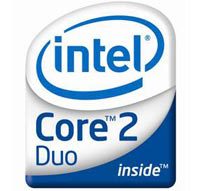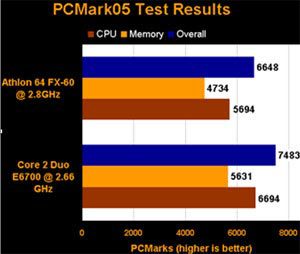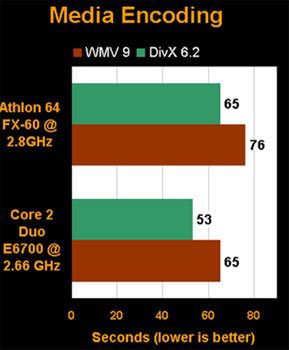The new microarchitecture platform that Intel aims to develop in the coming years is the Core. In 2006, the launch of two processor lines, Conroe (for desktops) and Merom (for laptops), is highly anticipated by experts in the field.
We present a practical review from the technology site ExtremeTech of the Intel Core2 Duo processor, part of the Conroe line, designed for the “mainstream” market segment. This product is set to officially launch in Vietnam in early August 2006.
 The ExtremeTech team visited Santa Clara, to a modern testing lab of Intel to conduct a series of real-world tests. However, ExtremeTech also noted that this should not be considered a true evaluation and that we must wait until the processor is officially announced.
The ExtremeTech team visited Santa Clara, to a modern testing lab of Intel to conduct a series of real-world tests. However, ExtremeTech also noted that this should not be considered a true evaluation and that we must wait until the processor is officially announced.
Preparation and Testing Procedures
As we mentioned, these tests were conducted on systems built and installed by Intel. We were allowed to examine all system setups, device drivers, BIOS settings, and applications – if there were any unusual applications running, we would have no trouble detecting them. Intel installed all applications for our testing and they were all ready to run immediately. While we could not use our own applications, there was nothing mysterious about the applications that Intel had pre-installed for us. All of them were popular applications and not specially optimized versions for Intel processors.
The only unfortunate point is that Intel did not have AMD’s current top processor using the AM2 socket for comparison. Instead, they used an FX-60 processor overclocked from 2.6GHz to 2.8GHz. Based on our experience, the operational performance of such a system would not differ much from an FX-62 processor using the AM2 socket with a real speed of 2.8GHz. An Intel representative explained that the FX-62 processor was not yet widely available on the market when Intel was setting up these testing systems; by the time this processor became available, Intel would not have enough time to install new systems and then thoroughly retest them to ensure they were set up correctly as Intel products. Below are the configurations of the systems participating in this testing evaluation:
| Component Equipment | Intel Testing Evaluation System | AMD Testing Evaluation System |
| Processor | Core 2 Duo E6700 with a default speed of 2.66GHz | Athlon 64 FX-60 dual-core overclocked to 2.8GHz |
| Motherboard and Chipset | Intel 975X | ASUS A8R32-MVP Crossfire |
| Memory | 1GB DDR2 667 | 1GB DDR 400 |
| Graphics | Radeon X1900 Crossfire | Radeon X1900 Crossfire |
| Operating System | Windows XP Pro SP2 | Windows XP Pro SP2 |
In our previous evaluation, we tested the highest-end Core 2 Extreme processor, but this time we will compare the top processor in Intel’s mainstream lineup with the Athlon 64 dual-core processor running at 2.8GHz. This Intel processor also features a 4MB L2 cache but has a lower clock speed than the 2.93GHz Core 2 Extreme. Naturally, it will also be priced lower. Both systems are similarly configured with dual Radeon X1900 Crossfire graphics cards using the latest drivers.
Overall Performance – PCMark05
 The PCMark05 testing program includes a comprehensive benchmark suite, with each benchmark designed to assess independent subsystems such as memory, processor, and hard drive. This test automatically detects the processor you are using and loads optimized dynamic libraries for the processor when testing each function. An Athlon 64 processor can fine-tune encoding tables to perform best on its architecture, while a Pentium 4 processor running the same test may run various encoding tables optimized for that processor. Many tests are small enough to fit within the L2 cache of new processors, so those tests, if run at a higher clock speed, will yield better results. This provides an ideal view of operational performance. In the real world, application optimizations may vary significantly.
The PCMark05 testing program includes a comprehensive benchmark suite, with each benchmark designed to assess independent subsystems such as memory, processor, and hard drive. This test automatically detects the processor you are using and loads optimized dynamic libraries for the processor when testing each function. An Athlon 64 processor can fine-tune encoding tables to perform best on its architecture, while a Pentium 4 processor running the same test may run various encoding tables optimized for that processor. Many tests are small enough to fit within the L2 cache of new processors, so those tests, if run at a higher clock speed, will yield better results. This provides an ideal view of operational performance. In the real world, application optimizations may vary significantly.
PCMark05 does not offer any specific optimizations for the Core microarchitecture platform, as this platform had not been announced when PCMark05 was developed. Nevertheless, the benchmark scores are quite impressive. The Core 2 Duo E6700, despite its lower speed, achieved an overall PCMark score and performance that surpassed the overclocked FX-60 processor. We are somewhat skeptical about the memory scores, as Intel’s testing system uses DDR2 memory while AMD’s testing system uses DDR. Currently, AMD processors fully support DDR2 memory.
Multimedia Encoding and POV-Ray Version 3.7 of the open-source ray tracing tool POV-Ray supports multithreading and SSE instructions. We enabled the “all CPUs” option in the POV-Ray program with the latest beta version (version 13) and recorded results in Pixels Per Second (PPS).
Version 3.7 of the open-source ray tracing tool POV-Ray supports multithreading and SSE instructions. We enabled the “all CPUs” option in the POV-Ray program with the latest beta version (version 13) and recorded results in Pixels Per Second (PPS).
The performance improved by 44% with the Core 2 Duo processor compared to a similar FX-62 system (if AMD had not significantly reduced prices).
We tested the DivX 6.2 encoding application using the DivX Converter bundled with the DivX product, processing a 24-second 1080p video with the Home Theater profile of children eating fruit. The Windows Media Encoder application test was slightly different, processing a 2-minute video of people surfing at the beach with a standard resolution of 720×480, converted using Windows Media Encoder 9 to 320×240 at 282Kbps. The audio codec used was Windows Media Audio 9.1, and the video was WMA9 Advanced Profile.
The Core 2 Duo processor continued to demonstrate impressive top-tier performance. The 2.66GHz Core 2 Duo processor ran the DivX encoding test application 22% faster and the WMV9 application 17% faster. These are extremely impressive figures when comparing processors that are somewhat different. We genuinely want to compare the Core 2 Duo processor with the actual FX-62 processor, but we still believe there won’t be a significant difference.
Gaming Performance
The latest benchmark from FutureMark, 3DMark06, is the comprehensive testing program we use to assess video card performance. This is the only test we use that is not a real game. Although this program does not accurately represent the load of current and future games, it does generate a suitable load reflecting the graphical quality in games for the video card, making it very appropriate for our testing. This new version focuses more on processors compared to the 3DMark05 version.
Intel performed slightly better in this test—after all, it is primarily a graphics benchmarking program. Notably, the new Core 2 Duo processor delivered a 9% higher performance in the processor test, despite a 5% lower clock speed.
Recall the first year or two of the Pentium 4 and Athlon 64 processors—when you saw AMD’s best processors delivering 20-30% faster performance in nearly every game you played?
The tables clearly show us the differences. We ran games at a resolution of 1024×768 and disabled AA and AF features to ensure the systems were not limited by GPU performance, but we maximized all other graphical options (surface resolution, special effects…) to ensure the system bandwidth was maximized as much as possible.
Performance differences in games are significant; we had to run several iterations of most games just to ensure accurate results. Then, we had to check game versions to ensure they all had the latest updates installed. We are talking about figures ranging from 15% to 30%, with even 54% in the case of Half-Life 2: The Lost Coast. The performance difference in this case was so high that we had to run tests up to four times on each test system and check the system settings for each run.
Excitement with Core We are very excited about the Core microarchitecture platform. The performance figures above are extremely promising. Note that the AMD system we tested performed almost on par with AMD’s top-tier FX-62 system, while the Core 2 Duo processor is not Intel’s highest-end processor. Instead, it is only Intel’s second-highest processor, behind the Core 2 Extreme. Yet this processor still delivered higher performance than the AMD system.
We are very excited about the Core microarchitecture platform. The performance figures above are extremely promising. Note that the AMD system we tested performed almost on par with AMD’s top-tier FX-62 system, while the Core 2 Duo processor is not Intel’s highest-end processor. Instead, it is only Intel’s second-highest processor, behind the Core 2 Extreme. Yet this processor still delivered higher performance than the AMD system.
Of course, these figures are still premature. While we are confident that the systems we tested were not specially assembled by Intel to achieve such superior results, we are not yet ready to give a 100% endorsement to this product until we have the opportunity to test these systems in our own laboratories and on systems we assemble ourselves.
Another notable point is that the Intel system we tested operated much quieter than the overclocked AMD FX-60 system. We weren’t in an ideal environment to accurately assess real-world noise levels, but it was immediately apparent that the Intel processor has a power consumption of 65W, while AMD processors consume 110W. These early test results suggest that Intel is increasingly realizing its ability to enhance performance while reducing power consumption in its products. As always, we will provide more objective evaluations when we have our own systems to test.


















































